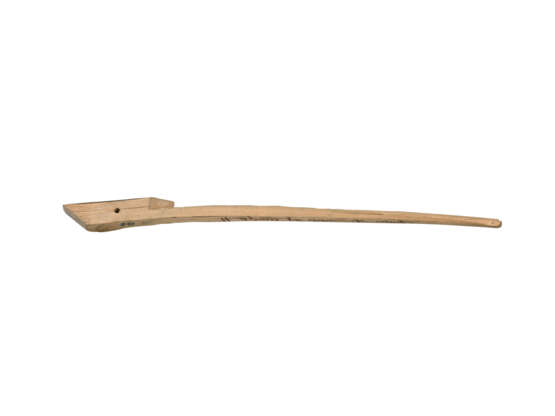ID 1449877
Лот 1 | A medieval tally stick
Оценочная стоимость
£ 4 000 – 6 000
Tally stick, in Latin, manuscript on wood [England, probably Westminster, 13th century]
A medieval tally stick: the instrument of the Royal Exchequer from which the term ‘stock’ originally derives and a rare survivor of the 1834 blaze that destroyed the Houses of Parliament.
c.190mm, cut from a piece of hazel or willow, carved with a series of 10 notches and inscribed in a 13th-century charter hand ‘[contra] Thom le Scot q cambiavit’, natural irregularities in the grain of the wood evident on the ‘inner’ edge where the stock and foil were split apart lengthways, edges squared off with a trace of bark remaining on one occasion, larger end cut diagonally and a hole bored through where previously threaded onto string, annotations in modern pencil. In a fitted cloth-bound box.
The split tally system was a supremely simple yet effective financial instrument used by the medieval English Royal Exchequer. Introduced under Henry I at the beginning of the 12th century, it recorded the payment of taxes. Tradition has it that the tally sticks were carved from willow harvested from the banks of the Thames, close to the Palace of Westminster. The sticks were inscribed with a series of notches – different types of cut denoted pounds, shillings and pence – and were then split lengthways, with the creditor retaining the longer half (the ‘stock’) and the debtor the shorter half (‘the ‘foil’). The natural grain of the wood meant that only two matching halves would fit together, which made the system almost impervious to tampering. During a royal audit, the official who had paid a sum into the Exchequer would have to be able to produce the corresponding stock which matched the split-away counterfoil retained at Westminster. Initially, tally sticks served simply as a record of a payment of taxes, but they soon became a form of currency in themselves. Because they could be presented to the Treasury as proof of taxes paid, they began to circulate in a secondary market, as a debt that could be traded for goods and services. Later, tally sticks began to be issued in advance, in order to finance war and other royal spending, and circulated as ‘wooden money’. The word ‘stocks’ endures to this day, used in Britain to refer specifically to the debts of the government.
The split tally system remained in use by the Exchequer until 1826. Following the abolition of the office of the Receipt of the Exchequer in 1834, tally sticks representing six centuries’ worth of financial records were ordered to be burnt in two furnaces at the Houses of Parliament. The resulting bonfire spread out of control and burned down the Palace of Westminster and the Houses of Parliament: Charles Barry's Gothic Revival structure that stands today is the result of the post-fire rebuild.
| Место происхождения: | Англия, Северная Европа, Европа, Великобритания |
|---|---|
| Категория аукционного дома: | Книги и рукописи |
| Место происхождения: | Англия, Северная Европа, Европа, Великобритания |
|---|---|
| Категория аукционного дома: | Книги и рукописи |
| Адрес торгов |
CHRISTIE'S 8 King Street, St. James's SW1Y 6QT London Великобритания | |
|---|---|---|
| Предосмотр |
| |
| Телефон | +44 (0)20 7839 9060 | |
| Комиссия | see on Website | |
| Условия использования | Условия использования |






